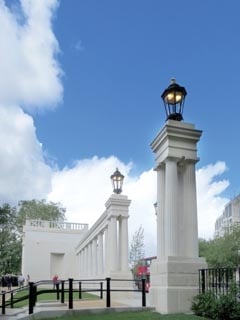Readers projects : Bomber Command Memorial London
It has taken a long time, but at last London has a memorial to the bomber crews of World War II – and a spectacular neoclassical edifice in Portland Whitbed and Basebed it is.
The Queen has unveiled a memorial in Green Park, London, to the 55,573 bomber aircrew who died in World War II.
It has taken 67 years for a memorial to be erected because the huge number of German civilian deaths caused by the bombing raids sat uncomfortably amid the attempts to bring peace to Europe after the war. The bomber crews were not even given campaign medals.
But the bravery of the 120,000 people who flew the missions that claimed the lives of almost half of them is at last commemorated in a Philip Jackson bronze sculpture of seven aircrew that sits at the heart of a 70m long, £7.5million neo-classical Portland limestone edifice designed by Liam O’Connor, the same architect who designed the Portland stone Armed Forces Memorial at the National Memorial Arboretum, among a great many other credits.
Not only is the stone the same as was used for the Armed Forces Memorial, it was worked and fixed by the same masonry company, S McConnell & Sons from Kilkeel, Northern Ireland, with lettering by the same artist-lettercutter, Richard Kindersley, who this time cut the letters into the stone by hand after the stone had been laid.
The Bomber Command memorial incorporates 77m3 of Jordans Whitbed, used for plinth courses, curved benches and the stonework above the architrave balusters and copings. There are 288m3 of Jordans Basebed in the two main masses of the structure and colonnades.
There were 1,861 stones supplied for the project, mainly as sawn two sides slabs. They include 34 architrave stones measuring 1,800mm long x 880mm wide x 650mm high, four niche heads 2,870mm long x 1,106mm wide and 605 high, 80 fluted column sections 560mm x 560mm x 1,180mm high, and a huge wreath stone measuring 1,600mm x 1,600mm x 725mm high that sits on a stone bench on the Green Park side of the memorial.
Both the architect and the stonemasons have taken exceptional care in the design and execution of the memorial, notwithstanding the shortening of an already tight build programme from 14 months to 10 so it would be finished before the start of the Olympics. Liam describes the programme as “immensely focused.”
It was, as it so often is, the stone company, McConnell’s, supported by the stone supplier, Albion Stone, which quarries the stone on Portland, who pulled out all the stops to keep the project on schedule.
It was an effort appreciated by the architect. Speaking on the eve of the opening he told NSS: “I think what drew us to McConnell’s was that they were able to work ceaselessly, 24-hours-a-day to deliver the stone package – and it’s extremely high quality stonework. They have done a truly splendid job.”
It had taken Liam O’Connor more than a year to come up with the first sketches for the memorial, which not so much reflects the RAF as complements the existing ceremonial architecture in this part of Westminster – notably the Corinthian order Wellington Arch and Ionic Decimus Burton screen. Liam chose Doric, the simplest of the classical orders, for his project.
And he paid such attention to detail that even the rivets holding the metal ceiling together are replicas of those used in World War II bombers. Rivets have also been carved into the stonework, and the ceiling itself is made from aluminium recovered from the Halifax bomber LW682 from 426 Squadron shot down on 12 May 1944 in Belgium and dug up again in 1997.
The crew, still at their posts, were properly buried and the aluminium from the aircraft frame was smelted down into bars that had been retrained as a momento. They were donated to the memorial and were turned back into sheet for use on the roof. “Somewhere in that roof is the DNA of those aircrew,” says Liam.
The site of the new memorial was described by English Heritage before the memorial was built as a rather forlorn corner of what was otherwise an interesting area. The 1970s work that made it that way has been swept away by the sparkling Portland stone.
“We have made rather a lot more out of that space,” says Liam. The memorial creates a new access to Green Park, with new street lighting based on the lamps on the Queen Victoria Memorial, new tree and hedge planting, new bollards. The combination of all the elements are described by Liam as “urban design gestures”.
He says the memorial is not “a one-liner”. “It creates urban clutter, in a way. It’s a space, not an object. You’re surrounded by the memorial. You don’t walk past it, you’re in it. You contemplate these huge inscriptions by Richard Kindersley. It’s a serious essay on the sacrifices made by these men. It’s a monument for quiet reflection.”
It is of traditional ashlar construction using particularly large stones. It includes engaged fluted columns with an entasis, which was one of the most complicated aspects of the structure and took months to design properly. Making the columns tested the skills of McConnell’s – each flute has its own centre and has to accommodate the slow curve of the entasis.
“There are blocks of stone weighing up to four tonnes,” says Liam. “It’s meant to be an essay on dealing with masonry in its most traditional manner. Where the columns meet the wall there are no joints. When you see that you realize this is massive masonry. It evokes some of the charm and wonder you get when you look at a cathedral. It will weather beautifully over a very long term.”

